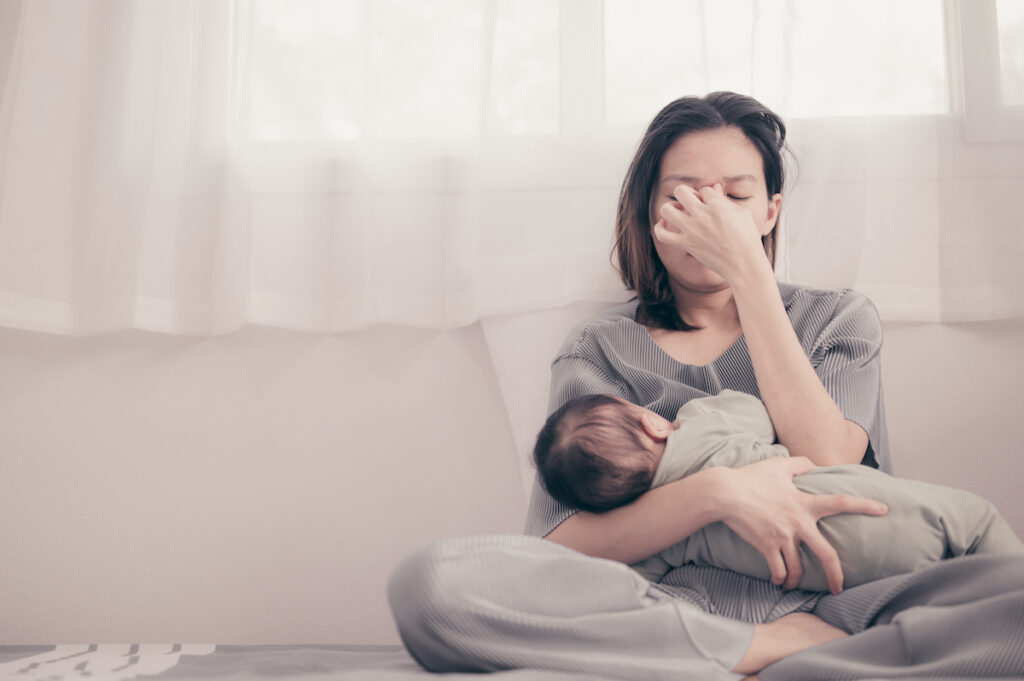
Being a parent isn’t easy. Having to care, nurture, educate and inspire a child, while simultaneously preserving your own mental health can be exceptionally challenging.
Parental stress is one of the largest contributors to depression in mothers (Thomason et al., 2014). As if the process of childcare isn’t demanding itself, many mothers may be more prone to stress and depression, due to societal barriers such as lower income and educational attainment (Field et al., 2006). This can foster a feeling like playing with the deck stacked against you.
The pathways by which stress impacts depression are complex, with not every mother who experiences chronic stress developing depression. One way to attempt to understand the underlying pathways is the Stress Process Model. It suggests that the relationship between chronic stress and depression may be mediated by other forms of stress and modified by personal and social resources (Pearlin, 1999). Social support and social capital are two types of social resources that may buffer against stress (Thoits, 2011). Wang et al., (2014) found that a mother’s social resources can protect against stress and poor mental health.
A recent study by Emma Nagy and colleagues (2020) strived to identify whether parental stress mediates the association between income, education status and depressive symptoms, and whether social support and network social capital moderate the pathway between stressors and depressive symptoms in mothers.

Stress related to parenting is one of the largest contributors to depression in mothers.
Methods
Data was collected through a sample of 101 mothers from Montreal, Canada. Depressive symptoms, which were coined as the outcome, were measured via the 20-item Centre for Epidemiologic Studies Depression (CES-D) scale. Socioeconomic stressors functioned as independent variables and investigated household income and education level. The mediator of parental stress was measured using the Parental Stress Scale. The moderators of this pathway were measures of social support and network social capital. Social network diversity and the presence or absence of a partner were measured to assess network social capital. Social support was measured by asking participants if they needed help with certain tasks or situations such as help with money, clothes, or food, babysitting, running errands, information or guidance and/or the need to talk to someone about something personal.
The data was analysed and modelled to investigate if parental stress mediated the associations between stressors and depressive symptoms. Firstly, the authors explored if income and education functioned as predictors of parental stress. Secondly they looked at income, education and parental stress as predictors of depressive symptoms. Finally, they examined if social capital and social support moderated this association.
Results
The results suggested that a high household income was associated with lower parental stress and fewer depressive symptoms. However, educational attainment was not associated with fewer depressive symptoms. Parental stress was found to partially mediate the association between household income and depressive symptoms, with parental stress mediating 60% of the total effect. Again, educational attainment was neither directly nor indirectly associated with depressive symptoms.
Results that explored if social support and social capital mediation the association, revealed that higher network diversity was directly associated with higher depressive symptoms. Network diversity moderated the relationship between parental stress and depressive symptoms, at high levels of stress, mothers with high compared to low network diversity reported fewer symptoms.

The findings indicated that parental stress partially mediates the association between household income and depressive symptoms, with parental stress mediating 60% of the total effect.
Conclusions
Findings highlight the role that socioeconomic factors play in influencing women’s risk of depression and shaping the benefits that ensue from social resources. Addressing these factors requires interventions that target the social determinants of depression.

This study suggests that socioeconomic factors play a catalytic role in influencing women’s risk of depression and highlights the benefits of social resources.
Strengths and limitations
All in all, this was a well-designed study, based on a community-based sample of mothers that yielded rich data on women’s social networks. Social capital was investigated comprehensively by both diversity in a mothers’ network and by the social support needed in a variety of ways. This information has the potential to shed light on the underlying pathways between low socioeconomic status and depression and help shape our understanding of how to help protect mother’s wellbeing.
However, there were significant limitations. Two main drawbacks the authors also identified were the study design and the operational definition of social support. Being a cross-sectional design, causal relationships can’t be inferred. For instance, a mother that has been diagnosed with depression may require more support than those without a diagnosis, adding to their parental stress. This would create a vicious circle of depression increasing anxiety and vice versa. Secondly, the authors used the concept of social support in their study. Haber et al. (2007) suggested that perceived support is a stronger indicator of mental health compared to received support, functioning as a self-fulfilling prophecy in a protective manner. Finally, from my point of view, there was a need for more diversity within the sample. Most women that participated in the study identified as white (82%), had a partner, and fell in the high-income category. Hence, being a minority or a single mother may have skewed the results in a different direction, so a bigger and more inclusive sample might be indicative.

Future studies should include more women from minority groups or single mothers in order to gain a bigger insight into the causality of this association.
Implications for practice
The findings of this study come to add to the circulating literature on the social determinants of maternal mental health. By identifying the pathways through which socioeconomic and parental stressors lead to depression in mothers, and simultaneously protective factors against it, public health initiatives can be informed on how to support mothers and their mental health (England & Slim, 2009).
Furthermore, they illustrate that parents with mental illness do not live in a bubble and that social and economic factors have a very catalytic role in the progression and outcome of their mental health. Hence the need for policies and interventions that address the social influences on depression, especially for people on low-incomes pose a necessity. Finally, by illustrating the protective role of social support, this evidence can act as a reminder to clinicians of the need to use and not set aside one’s social resources.

Public health initiatives can be informed by identifying the pathways through which socioeconomic and parental stressors lead to depression in mothers.
Statement of interests
None.
Links
Primary paper
Nagy E, Moore S, Silveira PP, Meaney MJ, Levitan RD, Dubé L. (2020) Low socioeconomic status, parental stress, depression, and the buffering role of network social capital in mothers, Journal of Mental Health.
Other references
Thomason, E., Volling, B. L., Flynn, H. A., McDonough, S. C., Marcus, S. M., Lopez, J. F., & Vazquez, D. M. (2014). Parenting stress and depressive symptoms in postpartum mothers: Bidirectional or unidirectional effects. Infant Behavior & Development, 37(3), 406–415.
Field, T., Hernandez-Reif, M., & Diego, M. (2006). Risk factors and stress variables that differentiate depressed from nondepressed pregnant women. Infant Behavior & Development, 29(2), 169–174.
Wang, X., Cai, L., Qian, J., & Peng, J. (2014). Social support moderates stress effects on depression. International Journal of Mental Health Systems, 8(1), 41.
Pearlin, L. I. (1999). The stress process revisited. In. C. S. Aneshensel & J. C. Phelan (EDS.), Handbook of the sociology of mental health (pp. 395–415). Academic Plenum Publishers.
Thoits, P. A. (2011). Mechanisms linking social ties and support to physical and mental health. Journal of Health and Social Behavior, 52(2), 145–161.
Haber, M. G., Cohen, J. L., Lucas, T., & Baltes, B. B. (2007). The relationships between self-reported received and perceived social sup- port: A meta-analytic review. American Journal of Community Psychology, 39(1–2), 133–144.
England, M. J., & Slim, L. J. (2009). Depression in parents, parenting and children: Opportunities to improve identification, treatment, and prevention. The National Academies Press.
Photo credits
- Photo by Marcos Paulo Prado on Unsplash
- Photo by Markus Spiske on Unsplash

Very interesting article.